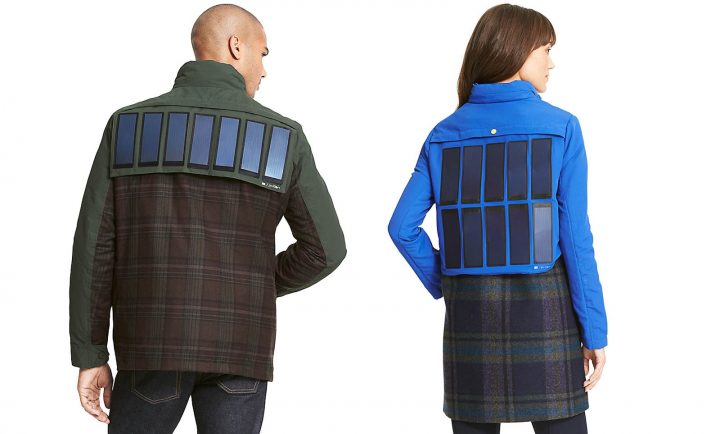Company: Pvilion
Project details
Fabric 1 name: Wool Tartan
Fabric 1 producer: Abraham Moon
Fabric 2 name: Nylon – Ottoman
Engineer: Pvilion
Design: Pvilion
Fabrication: Pvilion
Project manager: Pvilion
Please describe the project specifications.
We partnered with Tommy Hilfiger to design and produce two Solar Powered Jackets, a men’s and a women’s, exclusively for the 2014 holiday season. The product features a removable fabric solar panel unit that provides energy to power electronic devices such as mobile phones and tablets. These specialty jackets are available in select Tommy Hilfiger stores across Europe, North America, Latin America and Asia, and online at tommy.com. Our detachable, fabric, solar panel/wiring assembly snaps easily on and off the back of the limited-edition jackets, while a tubular webbing encased cable runs discreetly through the garment’s lining and connec ts the fabric solar panel to a removable battery pack in the jacket’s front pocket. A special snap-flap closure provides easy access to the battery pack, and its double USB port allows the user to conveniently connect it with up to two mobile phones, tablets or e-reader devices via USB cord. The battery pack can also be charged via a laptop or external power outlet, and when not in use, it stores energy for use at a later time. The water resistant, lightweight removable solar panel unit is made with flexible amorphous silicon technology that we developed. When exposed to full sunlight, the high output solar cells can fully charge the battery pack which, in turn, can fully charge a standard 1500mAh mobile device up to four times.
ts the fabric solar panel to a removable battery pack in the jacket’s front pocket. A special snap-flap closure provides easy access to the battery pack, and its double USB port allows the user to conveniently connect it with up to two mobile phones, tablets or e-reader devices via USB cord. The battery pack can also be charged via a laptop or external power outlet, and when not in use, it stores energy for use at a later time. The water resistant, lightweight removable solar panel unit is made with flexible amorphous silicon technology that we developed. When exposed to full sunlight, the high output solar cells can fully charge the battery pack which, in turn, can fully charge a standard 1500mAh mobile device up to four times.
What was the purpose of this project? What did the client request?
We asked the client if they had an appetite for wearable solar and they expressed interest to learn about it. We introduced their merchandisers and designers to basic flexible solar panel, wiring and battery form factors, color stories – and performance possibilities. We recommended that enough solar panels be used to generate sufficient power to truly have a real and noticeable effect and impact: enough voltage and amperage to actually keep the user’s cell phone powered with sunlight. They took two early stage projects in progress, men’s and woman’s coats for the Holiday 2014 season, and had the design teams work with us to incorporate our wearable solar tech into the designs. We sewed, wired and constructed a variety of exploratory samples in our prototyping shop, and then produced the order for final units in our shop, and with subcontractors.
What is unique or complex about the project?
“I’m excited to introduce wearable technology into our collection this Fall season,” said Tommy Hilfiger. “We were inspired by the fusion of traditional design techniques with technical mountaineering references. We also thought about what the adventurer of today would need and how our customers are interacting with technology in a more integrated way than ever before. Our solar power jacket celebrates classic design and tailored outerwear with innovative solar technology.” From a design aesthetic point of view, new wearable solar looks are more readily embraced in “wearable technology” circles, but less so in the fashion world where it is harder to break away from tradition. Solar panels on clothing can be considered “disruptive” and “too visible”. We enjoyed working with the designers at Tommy who took our solar tech and worked with the “grid” of the basic rectangular solar array and simply placed it on beautiful fabrics that also had “grids” (tartans) and in clothing which comprised rectangular elements that were sympathetic to grids (othogonal cut patterns, square pockets, horizontal storm flaps, etc.). From a technical point of view, the most complex aspect of the project was manufacturing all of the fabricated fabric solar panel and wiring assemblies that we made in the US, so that they mated perfectly (snaps, button holes, different sizes) with all of the clothing Tommy fabricated in China. For us, it was challenging to help bring flexible PV fabric technology to clothing, our background is in larger scale fabric-based structures and products: PV solar tensile structures, tents and inflatables. We are interested in helping cross this flexible PV fabric technology we have helped pioneer over to other fabric-based industries.
What were the results of the project?
From a ‘wearable tech in fashion’ point of view, we think the results are compelling as new “fashion looks” as well as new fashion “lifestyles”, and that this wearable solar project has helped sustainability to progress further into the high fashion “conversation”. From a larger, industrial fabrics industry point of view, we think this project has helped electric fabric advance towards the point where “all” fabric-based products, including tents, awnings, truck covers, boat tops, geotextiles, umbrellas, and military clothing, for example, will incorporate flexible PV fabrics and become power generators in addition to their original functions. The project was a successful one for Tommy Hilfiger insofar as all the units sold out, and a large amount of favorable press was obtained worldwide. We are currently in discussion for the next project with Tommy Hilfiger, also including fabric accessories such as handbags.
Content is submitted by the participant. IFAI is not responsible for the content descriptions of the IAA award winners.
 TEXTILES.ORG
TEXTILES.ORG



